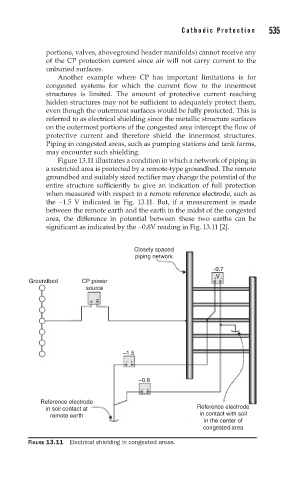Page 572 - Corrosion Engineering Principles and Practice
P. 572
534 C h a p t e r 1 3 C a t h o d i c P r o t e c t i o n 535
portions, valves, aboveground header manifolds) cannot receive any
of the CP protection current since air will not carry current to the
unburied surfaces.
Another example where CP has important limitations is for
congested systems for which the current flow to the innermost
structures is limited. The amount of protective current reaching
hidden structures may not be sufficient to adequately protect them,
even though the outermost surfaces would be fully protected. This is
referred to as electrical shielding since the metallic structure surfaces
on the outermost portions of the congested area intercept the flow of
protective current and therefore shield the innermost structures.
Piping in congested areas, such as pumping stations and tank farms,
may encounter such shielding.
Figure 13.11 illustrates a condition in which a network of piping in
a restricted area is protected by a remote-type groundbed. The remote
groundbed and suitably sized rectifier may change the potential of the
entire structure sufficiently to give an indication of full protection
when measured with respect to a remote reference electrode, such as
the −1.5 V indicated in Fig. 13.11. But, if a measurement is made
between the remote earth and the earth in the midst of the congested
area, the difference in potential between these two earths can be
significant as indicated by the −0.8V reading in Fig. 13.11 [2].
Closely spaced
piping network
–0.7
V –
Groundbed CP power +
source
–
–1.5 +
–
–0.8 +
Reference electrode –
in soil contact at Reference electrode
remote earth in contact with soil
in the center of
congested area
FIGURE 13.11 Electrical shielding in congested areas.

